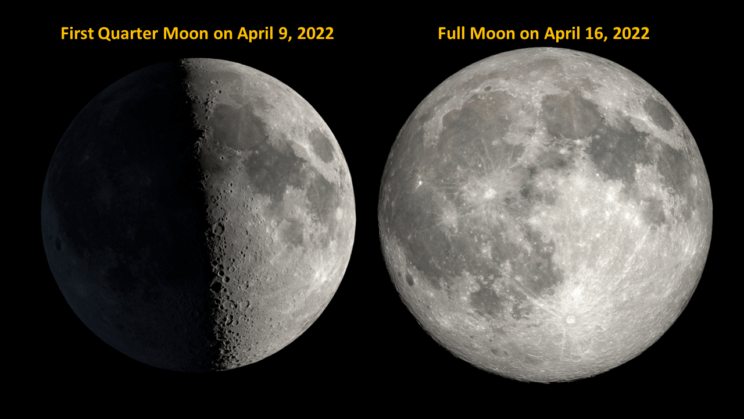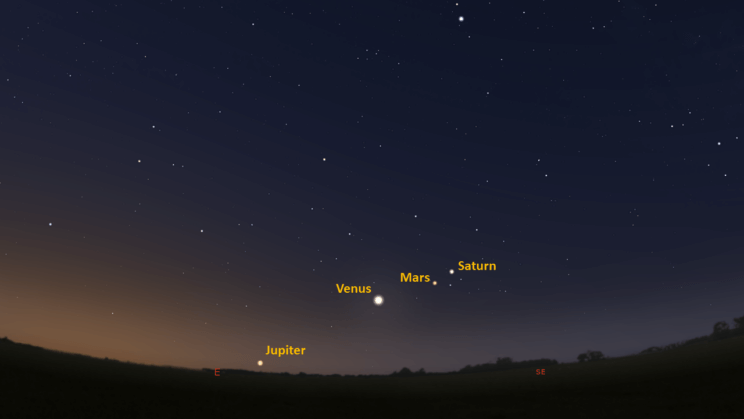This is the Saint Louis Science Center’s NIGHT SKY UPDATE for the week of Friday, April 8, 2022.
Information updated weekly or as needed.
Times given as local St. Louis time which is Central Daylight Time (CDT). For definitions of terminology used in the night sky update, click the highlighted text. If relying on times posted in Universal Time (UT), St. louis is -5 hours when CDT.
Public Telescope Viewings
With the changing recommendations from the CDC regarding COVID-19, conversations regarding the return of star parties at the Saint Louis Science Center have begun. We are close to bringing back our public telescope viewings, but a few details still need to be worked out. We will post future updates as we learn more about when we can bring back telescope viewings.
Observing Highlight of the Week

First quarter and full moon for the month of April 2022. Image credit: NASA, SVS Ernie Wright.
This week the Moon exhibits both its first quarter and full phases. The Moon takes 29.5 days to complete its phase cycle which means it hits a primary phase roughly every 7.375 days. The primary phases of the Moon are New, First Quarter, Full and Last Quarter. New and full moons occur when the Sun, Earth and Moon are in syzygy and first and last quarter phases occur when the Moon is at eastern and western quadrature respectively. Knowledge of the Moon’s position relative to the Earth and Sun helps us know when the Moon is visible and what tidal activity to expect.
The Moon will reach first quarter phase on April 9, 2022, at 1:48 a.m. When near first quarter phase, the Moon is easy to spot in the late afternoon before sunset. Daytime views of the moon are nice, but the contrast of the lunar surface and the bright day sky will make some lunar features difficult to see.
Full moon occurs on April 16, 2022, at 1:55 p.m. representing the fourth full moon of 2022. Keeping track of full moons each month is useful for several reasons. Typically, there is one full moon a month but occasionally there can be two. A long time ago we discovered the Moon’s synodic cycle (phase cycle) is a decent way to track the year. In this case, when we say year, we are talking about a tropical year which today we track with our modern calendar system. A tropical year represents a full cycle of seasons which is 365.242189 days long. Before we knew the Sun was a better tool for observing a cycle of seasons, the Moon was used. Because the Moon’s synodic cycle is 29.5 days long, a year measured with moon phases ends up 11 days short. Each cycle of seasons represents 12.4 lunar cycles. Before this was discovered, the moon phase cycle helped track the year.
One relic of this you may be familiar with is the naming scheme for full moons each month. You may have seen a name such as the Full Thunder Moon which is a common name for July’s full moon. The names chosen were meant to represent something connected to that time of year. July is a month in which we often have thunderstorms. April’s full moon is sometimes called the Full Pink Moon to signify the spring blooming of flowers. Several other names are also given which are dependent on regional activities. Several of these names for April’s full moon are: Breaking Ice Moon, Frog Moon or Sucker Moon. These names are a good reminder that for thousands of years, we looked to the sky to help understand and monitor the changing world around us.
Another reason to be aware of full moon is it has an impact on observing. When the Moon is near its full phase, it will appear significantly brighter. The reason for this is called the opposition effect. The best way to visualize this is to think of a sundial. Sundials use something called a gnomon which is typically something with vertical relief that casts a shadow. As the Sun rises and transits the sky, the shadow cast by the gnomon will be long when the Sun is low to the horizon and short when high in the sky. Objects on the lunar surface from specks of dust to entire mountains also act as gnomons. When the Moon is near its full phase the Sun would appear high overhead if you were standing on the lunar surface. With shadows beginning to point towards the antisolar point, there will be a higher ratio of bright areas to shadowed areas. This makes the Moon look brighter. This has a major impact on how dark the sky is and what you can see.
Lastly, the next full moon in May will be one to look forward to. On May 15, 2022, the Moon will enter Earth’s shadow causing a total lunar eclipse. The eclipse begins 8:32 p.m. and ends at 1:50 a.m. on May 16, 2022. We will expand on the eclipse more in May.
The Sun and Moon

The Moon as seen from the International Space Station, on July 31, 2011.
Credit: NASA
Sunrise is at 6:35 a.m. on Friday, April 8 and sunset is at 7:31 p.m. providing us with roughly 13 hours of daylight. Even after sunset, the light from the Sun will dimly illuminate our sky for roughly 1 hour and 30 minutes. This period is called twilight, which ends around 9:04 p.m. this week. For those with a sundial, local noon occurs around 13:02 p.m. this week.
| Day | Sunrise | Sunset |
|---|---|---|
| 2022-04-08 | 6:35 a.m. | 7:31 p.m. |
| 2022-04-09 | 6:33 a.m. | 7:32 p.m. |
| 2022-04-10 | 6:32 a.m. | 7:33 p.m. |
| 2022-04-11 | 6:30 a.m. | 7:34 p.m. |
| 2022-04-12 | 6:29 a.m. | 7:35 p.m. |
| 2022-04-13 | 6:27 a.m. | 7:36 p.m. |
| 2022-04-14 | 6:26 a.m. | 7:37 p.m. |
| 2022-04-15 | 6:24 a.m. | 7:38 p.m. |
| 2022-04-16 | 6:23 a.m. | 7:38 p.m. |
Moon
Moonrise for Friday, April 8 occurred at 11:13 a.m. and moonset will occur at 2:53 a.m. on the following day. On Friday, April 8, the Moon will exhibit a waxing crescent phase with 47% of the lunar disk illuminated. First quarter moon occurs on April 9, 2022, at 1:48 a.m.
International Space Station (ISS) Observing

There are no visible passes of ISS from St. Louis until April 21, 2022, when it returns to the morning sky.
Magnitude (Mag): The Measure of brightness for a celestial object. The lower the value is, the brighter the object will be.
Altitude (Alt): The angle of a celestial object measured upwards from the observer’s horizon.
Azimuth (Az): The direction of a celestial object, measured clockwise from an observer’s location with north being 0°, east being 90°, south being 180° and west being 270°.
For information about ISS flyovers and other visible satellites, visit www.heavens-above.com
Detailed information regarding all unmanned exploration of our universe, missions past, present, and planned, can be found at Jet Propulsion Laboratories:
The Visible Planets

Looking southeast at 5:45 a.m. April 9, 2022. Jupiter is above the horizon but it will be difficult to see. Credit: Stellarium, EG
This week, three naked eye planets are visible. Venus, Mars and Saturn are seen in the southeast before sunrise.
Venus
Venus has started a morning apparition and will be seen in the southeast before sunrise. Venus rises at 4:46 a.m. and should be easy to spot in the southeast by 5:45 a.m. The current morning apparition lasts until the third week of October 2022. Venus reaches superior conjunction on October 22, 2022.
Mars
A new apparition for Mars has begun. Mars rises at 4:30 a.m. Start looking for Mars around 5:30a.m. as it clears trees and buildings. Mars will continue to climb out of the Sun’s glare as it heads towards opposition later this year on December 7, 2022.
Saturn
Saturn rises at 4:20 a.m. Start looking for Saturn around 5:20 a.m. in the southeastern sky. Saturn will reach opposition on August 14, 2022. As we head to this date, Saturn will rise earlier each day.
James S. McDonnell Planetarium
Night Sky Update: April 8 – April 16, 2022







